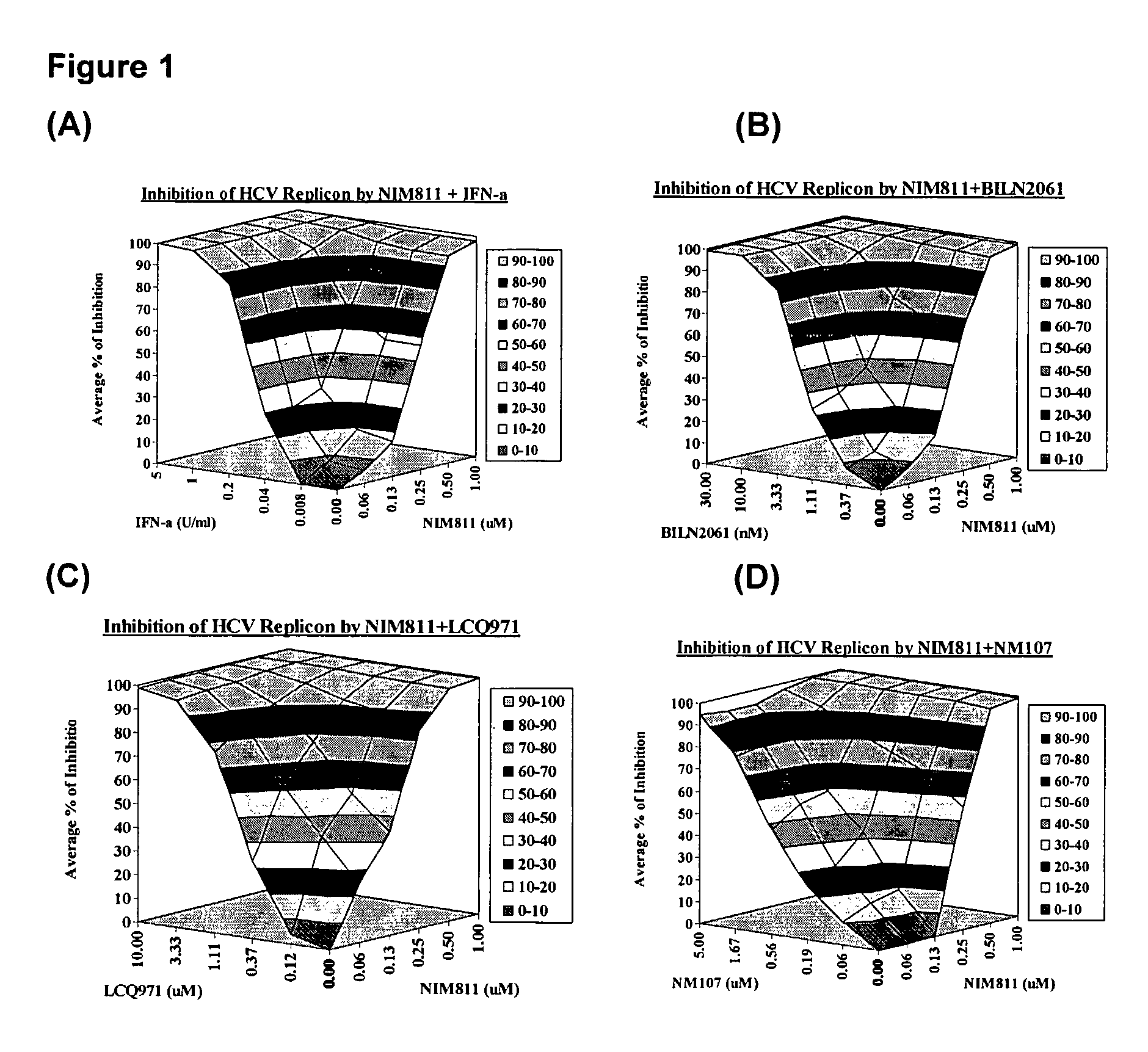Compositions for HCV treatment
a technology of compound compounds and cyclosporins, applied in the field of pharmaceutical chemistry, can solve the problems of inability to inhibit cn and the downstream nf-at pathway, and insufficient binding to cyclophilin
- Summary
- Abstract
- Description
- Claims
- Application Information
AI Technical Summary
Benefits of technology
Problems solved by technology
Method used
Image
Examples
example 1
In Vitro Assays
[0115]Cell culture: HCV replicon cell line, clone A, is obtained from Apath, LLC. The cells are cultured in Dulbecco's modified Eagle's medium (DMEM, Gibco), containing 10% heat-inactivated fetal bovine serum (FBS, Gibco), 2 mM L-glutamine, 1× nonessential amino acids (Gibco), and 1 mg / ml G418 (Invitrogen, Carlsbad, Calif.).
[0116]The HCV replicon cell line, Huh-Luc / neo-ET, is obtained from ReBlikon GmbH. The cells are cultured in Dulbecco's modified Eagle's medium (DMEM, Gibco), containing 10% heat-inactivated fetal bovine serum (FBS, Gibco), 2 mM L-glutamine, 1× nonessential amino acids (Gibco), and 0.25 mg / ml G418 (Invitrogen, Carlsbad, Calif.).
[0117]QRT-PCR-based HCV replicon assay: To determine antiviral effect of the compounds, HCV replicon cells clone A are treated with compounds serially diluted in DMEM supplemented with 2% FBS and 0.5% DMSO for 48 h, then the total intracellular RNA is extracted, and the level of HCV RNA is determined by real-time quantitative...
example 2
Combination Analysis
[0119]The effect of drug-drug combination is analyzed using Bliss Independence model, a three-dimensional analytical method developed by Prichard, M. N. and Shipman, C, 1999, Antivir. Res. 14:181-205. In this model, theoretical additive effects are calculated from the dose-response curves of individual compounds using the equation: Z=X+Y(1−X), where X and Y represent the inhibition produced by drug 1 or drug 2 alone, respectively, and Z represents the effect produced by the combination of drug 1 and drug 2. The theoretical additive surface is subtracted from the actual experimental surface, resulting in a surface which would appear as a horizontal plane at 0% inhibition if the combination was merely additive. The 95% confidence intervals for the experimental dose-response surface are used to evaluate the data statistically.
[0120]Analysis of the effect of combination treatment, are examined using nine-day viral RNA reduction assays. HCV replicon cells clone A are ...
example 3
Resistance Frequency Analysis
[0127]HCV replicon cells clone A are treated with various concentrations of NIM811 and BILN2061 either alone or in combination in the presence of 1 mg / ml G418. Resistant colonies start to form after treating the cells with BILN2061 for 2 weeks. Cell cultures collected after 3 weeks of treatment are shown in FIG. 3. The numbers of resistant colonies are also shown. There is a drastic reduction of resistance rate with the combination of NIM811 and BILN2061 than either compound alone. This data suggests that the combination therapy would help to suppress the emergence of resistance.
PUM
| Property | Measurement | Unit |
|---|---|---|
| concentrations | aaaaa | aaaaa |
| concentration | aaaaa | aaaaa |
| water-soluble | aaaaa | aaaaa |
Abstract
Description
Claims
Application Information
 Login to View More
Login to View More - R&D
- Intellectual Property
- Life Sciences
- Materials
- Tech Scout
- Unparalleled Data Quality
- Higher Quality Content
- 60% Fewer Hallucinations
Browse by: Latest US Patents, China's latest patents, Technical Efficacy Thesaurus, Application Domain, Technology Topic, Popular Technical Reports.
© 2025 PatSnap. All rights reserved.Legal|Privacy policy|Modern Slavery Act Transparency Statement|Sitemap|About US| Contact US: help@patsnap.com



